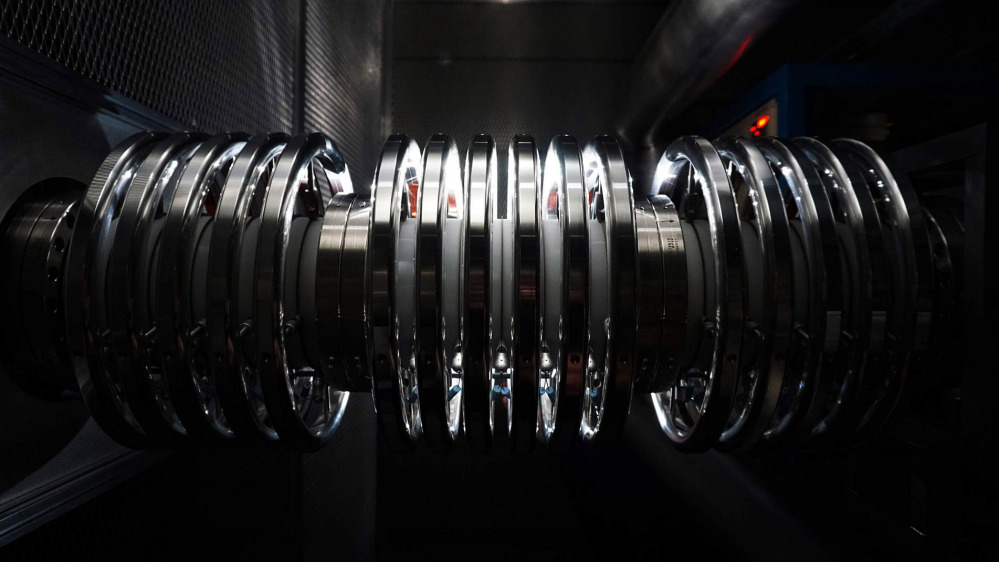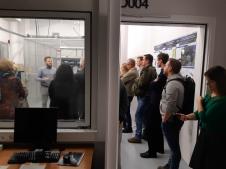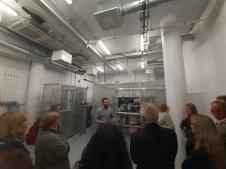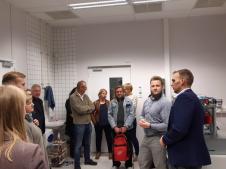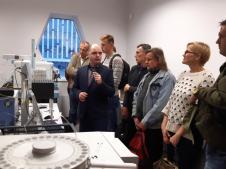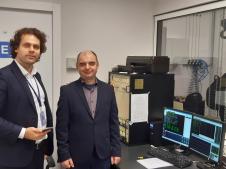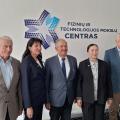Naujienos ir renginiai
- Titulinis
- Naujienos ir renginiai
- Naujienos
Naujienos
2019. 10. 14
-
FTMC scientists perform radiocarbon dating
What is the most accurate way to determine when and where a human or animal whose remains were discovered during archaeological excavations? How do you know if a famous artist's work and an antique antique chair - the legacy of a great-grandfather - aren't just great fakes? Who will say how much radioactivity has increased in the environment of an inactive nuclear power plant, and - is it possible to eat fish caught there?
These are just a few examples of one of the most accurate and comprehensive methods - radioactive carbon dating. Scientists at the Mass Spectrometry Laboratory, Center for Physical and Technological Sciences (FTMC), the only conduct such research in the Baltic States with the state-of-the-art equipment presented their activities and ongoing research to the members of the Lithuanian Archaeological Society - archaeologists and scientists from various Lithuanian institutions.
In addition to radiocarbon dating researchers at FTMC's Mass Spectrometry Laboratory also implements different research programs. FTMC research team named VilniusRadiocarbon presented their works to archaeologists and scientists from various Lithuanian institutions.
From analysis of the composition of juice or polluting particulate matter to the most complex investigations of contamination of the environment of the Ignalina Nuclear Power Plant and the dating of unique, even burned, archaeological findings, - according to FTMC dr. Žilvinas Ežerinskis, a brief presentation of the work of qualified scientists of the Laboratory of Mass Spectrometry of the Nuclear Research Division:
“In scientific terminology, we are conducting a complete analysis of radiocarbon dating for archaeology and source identification in the environment. We date charcoal, plants, seeds, peat, soil, textiles, wood, shells, burnt food remains in ceramics and various other specimens. We prepare samples for testing and develop the most innovative radio carbon dating technology - we can accurately and quickly date even burned bones. With this method, we can determine the exact age of a geological or archaeological sampel between now and 50,000 years ago, ”said FTMC Dr. Ž. Ežerinskis.
During the event, dr. Andrius Garbaras (FTMC) presented the research work of VilniusRadiocarbon team and possibilities in the field of identification of sources of environmental pollution. By combining stable isotope ratio spectrometry with radiocarbon measurements, the isotope ratio can be used to study the origin and dispersion of aerosol particles in the atmosphere: carbon, nitrogen, sulphur, hydrogen, oxygen, etc.
Scientists have provided an example of how using this metho they found that the biggest pollutant in winter in Vilnius is not the emissions of cars, but particles of organic fuel (firewood, briquettes, biomass, etc.).
“At FTMC laboratories, we have measured at least 15,000 of samples since 2006 we have published about 50 publications in scientific journals. We are collaborating and sharing knowledge with colleagues in Ireland, Sweden and around the world because we can only achieve good results by sharing experiences with researchers from other countries. ” A. Garbaras.
Number of samples, accuracy, duration of radiocarbon dating
Algirdas Pabedinskas, a PhD at FTMC working in the Mass Spectrometry Laboratory, explained how samples are prepared and how the radiocarbon dating process takes place. The VilniusRadiocarbon team works on highly sensitive mass accelerator spectrometer technology, so many samples can be extremely small: half a gram or a few milligrams.
“In simple terms, you need to prepare samples before testing. Biological object under investigation - burnt bones, fish scales, fragments of old furniture, etc. - in chemical processes we have to transform it into a gaseous state, CO2. Finally, the graphite sample is pressed into an aluminium cathode. Five replicates should be prepared per sample.
During the test, the radiocarbon collected from the sample is measured using an Accelerated Mass Spectrometer (AMS). It determines the age of the object under investigation. The measurement speed is one day, and all datingd work is done within 5 weeks after receiving the samples - and even faster if there is a need, ”said A. Pabedinskas.
This summer, FTMC VilniusRadiocarbon has acquired an additional innovative radiocarbon dating sample entry system, the AMS appendix. From now on, specimens can be submitted and analysed not only in graphite but also in gaseous CO2.
“The innovative spectrometer accessory contains 10 samples and can be used to shorten the process in one step. This means that 10 times smaller samples are now required. Actually, we will use 10 times less amount of the object being researched - mostly invaluable material: antiques, archaeological finds, etc. ”- stresses A. Pabedinskas, a researcher at VilniusRadiocarbon.
The mammoth of Vilnius, the skull of a rhinoceros, cave lion (Latin Panthera leo spelaean) are just a few interesting historical treasures whose age has already been determined by FTMC scientists using the method of radiocarbon dating. Each object studied has an interesting and unique story. For example, the owner of the beast's skull needed to have a document certifying the age of the skull in order to be able to travel freely across countries while giving lectures.
The exactly determined age of paintings, textiles and wooden furniture does not always coincide with the expectations of the owner. Dr. Ž. Ežerinskis told the story for guests about dating case an old, framed picture in the laboratory. Its owner, a flea collector, had no doubt that it was an original painted by a Florentine artist. However, the objective dating of radiocarbon found it to be a "younger", admirably crafted counterfeit of all ages.
"Significant number of Lithuanian archaeologists have already used our services and were surprised to discover that such measurements are being made in Lithuania as well," said Dr. Žilvinas Ežerinskis (FTMC). - "We strive for investment in scientific equipment would create value not only for science and high-level specialist training, but also for Lithuanian companies."
Environmental pollution by radioactive material emissions from Ignalina Nuclear Power Plant in adjacent trees is currently researched by PhD A. Pabedinskas emphasizes:
“Most importantly, radiocarbon dating is an absolutely objective and unbiased. Research objects used during dating - old organics, environmental pollutants, etc. is an independent source of information, assisting researchers to recreate and identify significant investigation details”
Until now, Lithuanian archaeologist have been sending samples to laboratories in Germany, Great Britain, Switzerland, Poland or other countries. So the scientists of the Lithuanian Society of Archaeologists gathered at the event were pleased that measurements can now be made in Vilnius, at the FTMC dating laboratory VilniusRadiocarbon.
Gallery
Susiję:
